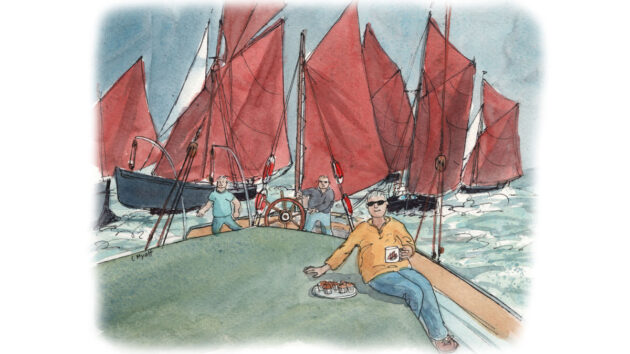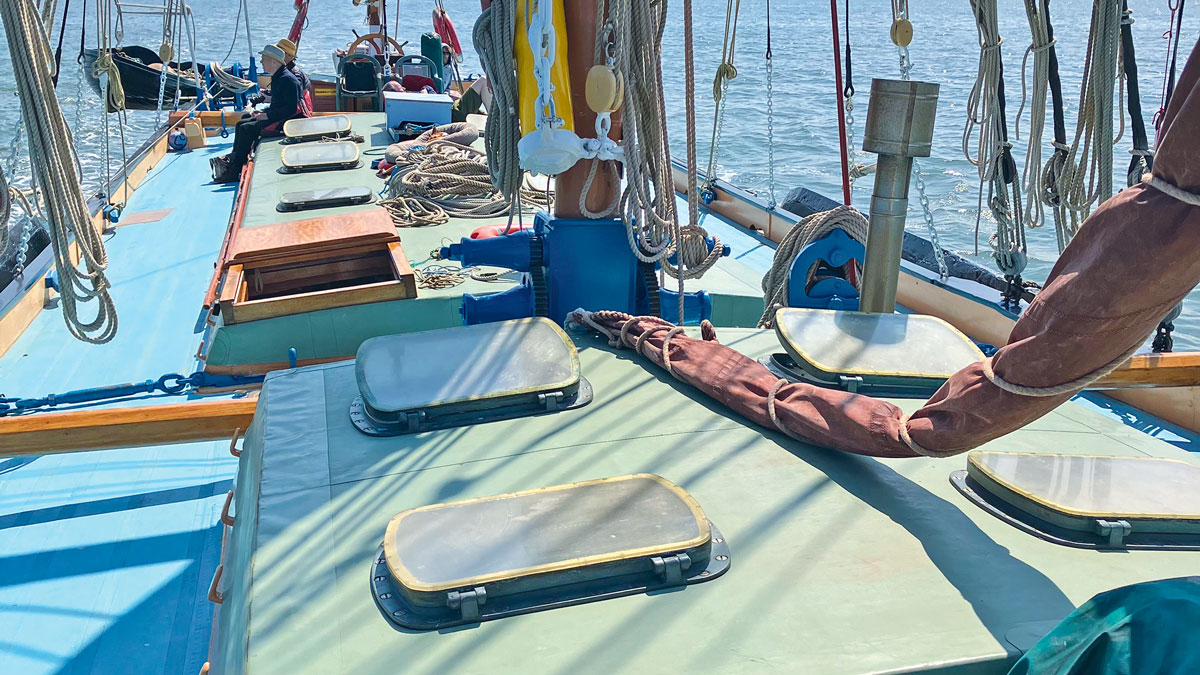The art of juggling tea and a muffin while not tripping over or getting whacked on the head aboard a Thames barge, is among the skills Dave Selby has learned in his long association with these magnificent craft.
As Rob executed the deftest pirouette this side of the Bolshoi Ballet and Alfie demonstrated the lassoing skills of a rodeo champion, the youth of Ipswich eyed us with the kind of bemused consternation you’d expect if a travelling circus had just landed in town from another century.
I was bemused by this as all that had happened was that skipper Rob had swivelled the 82-ton Thames barge Thistle with the poise of a ballet dancer on points and Alfie, the mate, had tied us up.
Neither was Rob wearing a tutu, nor was Alfa kitted out in leather chaps and a stetson; while I, as usual, was doing my best to look normal.
Hours before, on passage from Maldon we’d passed Felixstowe container port, which had brought in the youngsters’ vapes, Ipswich Town football shirts and the e-scooters and bicycles scattered about them on the quay.
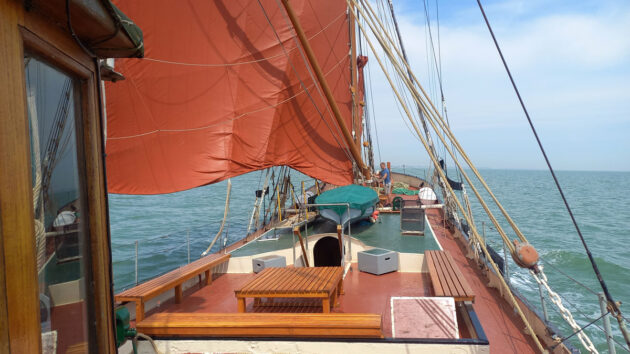
Sailing aboard Thistle. Credit: Dave Selby
In a time gone by Thistle, built in 1895, would have delivered the necessities and luxuries of life.
And as we stepped ashore the youngsters barraged us with questions.
Where are you from? Is it a pirate ship? How fast is it?
What are those flipper things? (answer: leeboards); What are leeboards? (Rob explained that); How can I get a go on one?
Thames barge racing
There’s no such thing as a dumb question, nor were any of them dumber than any I asked when I first encountered a Thames barge.
The difference is that I’ve been lucky enough to sail on these magnificent machines for 20 years, and the next day I was to take part in the spectacle of the 63rd Pin Mill barge match aboard the sailing barge Victor.
Built in Ipswich in 1895 and still operating from there, she’s part of the fabric of the town.
For long-time skipper Wes this was to be his last barge match before retiring.
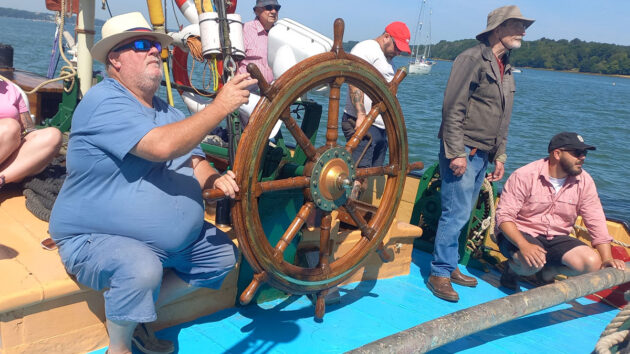
For skipper Wes this was to be his last barge match before retiring. Credit: Dave Selby
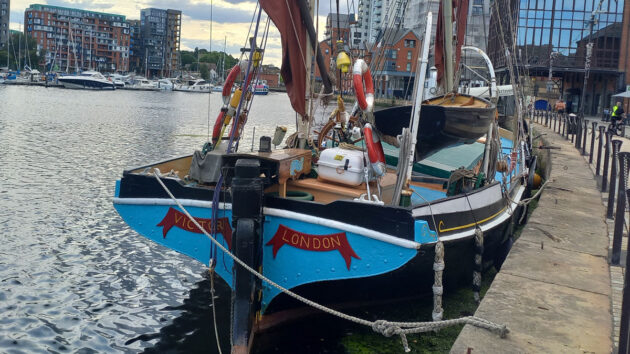
Until the Second World War, Victor collected linseed from farms around the East Coast and took it to Owen Parry’s Mill in Colchester returning to London with the oil in barrels. It is thought that this cargo may have in large part contributed to her excellent condition. Photo credit: Dave Selby
But just think about those numbers for a second.
The first Thames barge match took place in 1863, making these contests among the oldest sailing competitions in the world.
Of the dozen or so barges taking part in this year’s match all but one were built between 1890 and 1930.
In the briefing aboard Victor I was appointed to a role for which I’m eminently suited and perhaps even over-qualified: guest.
Like everything on barges this is harder than it sounds, as it involves juggling a mug of tea and a muffin while trying not to trip over something or get whacked on the head.
When sailing in trade Thames barges usually had a crew of just a man and a boy, neither encumbered by muffins.
Fast Thames barges
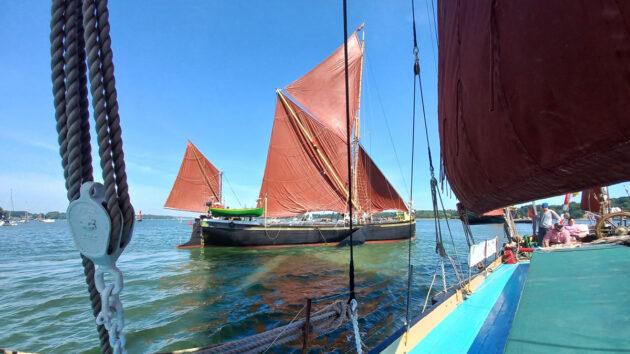
Victor crossed tacks with other barges at close quarters, yet there was never a raised word from skipper Wes. Photo credit: Dave Selby
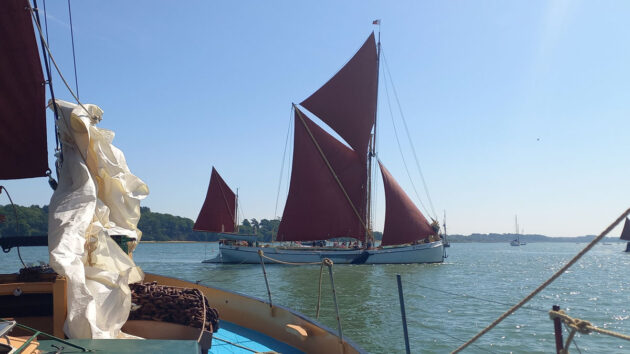
For the race we had half a dozen crew.
I watched in wonder as Victor crossed tacks at close quarters with barely a word of command, and never a raised one, from skipper Wes.
At each tack one lee board was raised and the other lowered as the ring of a main sheet block the size and weight of an anvil shoots from side to side along a huge horizontal wooden beam known as the horse.
The forces involved are phenomenal.
Meanwhile, there are the vangs to attend to; these are the lines that control the top of the sprit, to shape the main and top sail.
Further forward are the running back stays that are released and tightened through the tack to support the towering top mast.
While up front the foresail is held aback with a rope known as a bow line, and on release the sheet ring careers across the fore horse.
It was here I encountered a local lad of 15 who, on just his second barge trip, was entrusted to handling the foresail bow line through the tack, his face a study of intense concentration.
Overseeing him was mate Sam, just a few years older.
The posh term for this is “community engagement,” which is something skipper Wes had been doing informally for years.
And that could play a bigger part in Victor’s future.
This historic barge is now for sale and the Ipswich Maritime Trust is raising funds to keep her in her birthplace.
Ipswich is the oldest continuously occupied port in our country, but many youngsters, like the ones we encountered earlier on the quay, have somehow lost connection with it.
Sam and the other lad could have answered their questions and it’s hoped Victor will be big part of the solution.
The beauty of the Thames barge, Greta
Small-boat fanatic Clive has a day off his usual trailer-sailers to savour the wonderful and much bigger world of the…
Sail boat rigs: the pros and cons of each popular design
Peter Poland looks at the history of popular rig designs and how the different types affect boat performance
Becoming an Old Gaffer – How I found my ideal boat
I don’t own Wendy May, she owns me. I’m just the custodian. She was built for an army officer in…
Want to read more articles like this?

A subscription to Practical Boat Owner magazine costs around 40% less than the cover price.
Print and digital editions are available through Magazines Direct – where you can also find the latest deals.
PBO is packed with information to help you get the most from boat ownership – whether sail or power.
-
-
-
- Take your DIY skills to the next level with trusted advice on boat maintenance and repairs
- Impartial, in-depth gear reviews
- Practical cruising tips for making the most of your time afloat
-
-
Follow us on Facebook, Instagram, TikTok and Twitter




